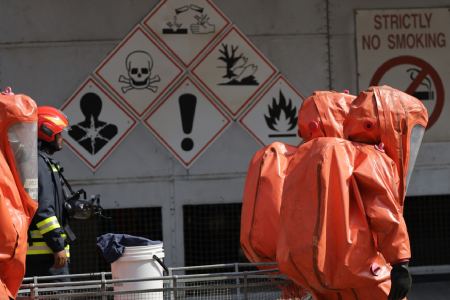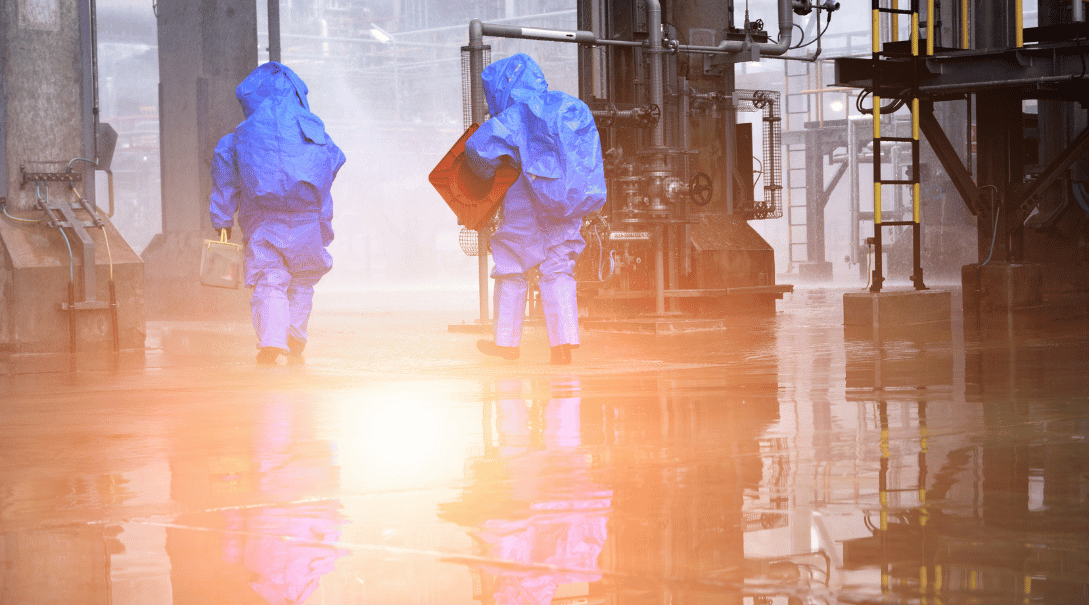In the event of a chemical spill, taking action quickly and responding in accordance with the proper chemical spill response procedure is absolutely critical. Crews who do not adhere to set protocols can only worsen the problem.
For example, if a container of benzene spills onto a factory floor, immediate dangers arise from its high toxicity and flammability. If the benzene is not washed away in time or otherwise not appropriately cleaned up, it could lead to an increased fire risk and adverse health effects for every worker involved. The benzene must be disposed of according to strict regulations, too, or it risks leaking into the surrounding environment and causing further harm.
While it’s essential to have a chemical spill emergency response plan in place to protect workers in the event of a spill, not all businesses that handle containers of dangerous chemicals are equipped to handle a thorough cleanup themselves. Scenarios like the one outlined above are precisely why handling chemical leakage should be done by an experienced professional response company.
Table of Contents
Assess the Situation

- The size and amount of the spill
- The type of chemical involved
- The location of the spill
- The number of personnel members nearby
If you and your team cannot identify any hazardous conditions immediately, you can call in trained professionals to assess the danger levels. Remember, though, that speed is of the essence, so if you rely on outside help, keep the contact information of a hazardous chemical spill response firm high on your chemical spill response checklist.
Once you’ve assessed whether the spill poses a threat, you can take appropriate action. That’s why accurate analysis is essential: Every subsequent step hinges upon quickly and properly calculating the hazard level of the spill.
Evacuation
All personnel must evacuate the spill area to ensure everyone’s safety before any cleanup procedures can occur. Determine whether anyone has come into contact with the chemical or breathed in any noxious fumes, as they will need appropriate medical attention immediately.
Following your initial evacuation protocol, ensure the security of the perimeter. If an employee is unaware of a chemical spill, they may enter the area and risk contracting and spreading further contamination.
Furthermore, ensure every employee has access to a chemical spill response guide or plan so they know what to do in case of a spill. Such a plan should include the following details:
- Proper evacuation procedures
- Routes to take
- Where to seek medical attention
- Who to report a spill to
- Any emergency signals or alarms to trigger
If you have employees who will be involved in the cleanup and disposal process, indicate what type of personal protective equipment (PPE) they will need and where to find it.
Emergency Response
From here, it’s time to call emergency services. Depending on the severity of the spill, you may or will need to call:
- The fire department
- A hazardous materials team
- The National Response Center
Having the right chemical spill emergency response services on hand is indispensable. Their speed and accuracy with the cleanup process can mean the difference between avoiding a disaster and experiencing a disaster.
Alpha-Omega Training and Compliance (AOTC) can assist with examining the situation and evacuating individuals from the area. We can also determine whether you will need to call the fire department.
Spill Containment
You will need to ensure that the chemicals can’t spread further and potentially harm people, the environment, or property as a result. Preventing the spread of hazardous chemicals is necessary before cleanup can occur, and isolating the spread of the chemicals will make the spill easier to clean.
Keeping chemicals from escaping requires the right tools, such as:
- Absorbent materials that won’t react with the chemicals
- Dikes
- Booms
- Well-sealed doors
Ideally, the chemicals will not have spilled near any drain, but if they have, ensure that the connecting pipes can be sealed or redirected to prevent the chemicals from leaking into the sewer or underground. Depending on the type of chemical involved in the spill, some recovery and reuse may be possible. However, that shouldn’t be the first goal; instead, focus on safety and enacting the proper chemical spill response procedures.
Control and Neutralization

Using the wrong neutralizing agents, however, can cause more intense reactions that are often more dangerous than the initial spill, so again, relying on professional cleanup services may be necessary to avoid disaster.
Chemical Spill Cleanup
It’s important to understand that your chemical spill response plan doesn’t end by simply cleaning up the spill. Those dangerous chemicals still need to be properly disposed of. The scope of the cleanup and disposal process depends on the following factors:
- The size and scope of the spill
- What chemical or chemicals spilled
- The size of the threat posed by the chemicals
Remember that although some chemicals can be taken as a right to a landfill, others require more extreme methods to get rid of, such as incineration. You must follow the guidelines and regulations for the chemicals you are cleaning or ensure the company you hire to clean follows the rules. If the chemicals aren’t cleaned or disposed of thoroughly, they can lead to massive environmental damage and cause great harm to human, animal, and plant life.
Documentation
All cleanup efforts require thorough documentation. You will need this information to receive insurance payments, so without it, you won’t be able to prove that the cleanup was performed properly
You will need to keep detailed records of the following:
- The type and amount of chemicals spilled
- The steps are taken in response to the spill
- The results of your cleanup efforts
Review
Finally, you will need to restore the area to its pre-spill condition. Repairing any damage is essential to getting your business back on track and continuing to serve your stakeholders and community. You can restore any trust lost after the spill with a thorough cleanup plan and accurate documentation.
When to Contact Alpha-Omega Training and Compliance Inc.
Should you ever have to tackle a chemical spill cleanup, you can rely on AOTC to limit the damage with a thorough and compliant cleanup procedure. Our 24-Hour Emergency Spill Response service is a reliable, affordable solution to your spill cleanup problems. With our micro-ER units, we can be on-site quickly, so make sure you include us as part of your chemical spill response plan! AOTC offers environmental remediation services as well.
